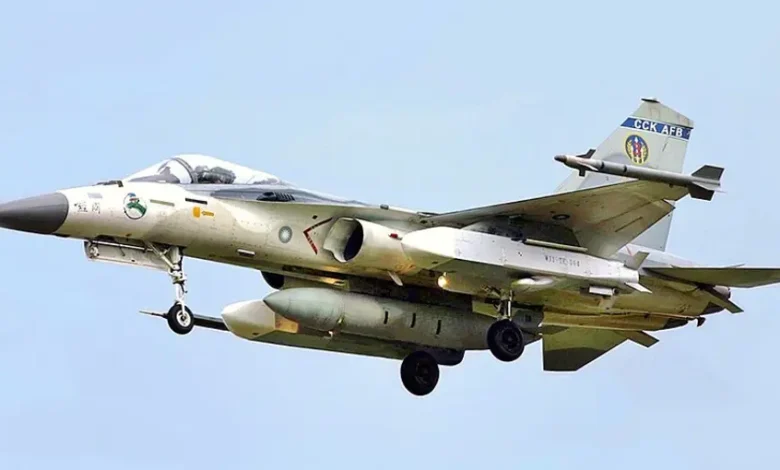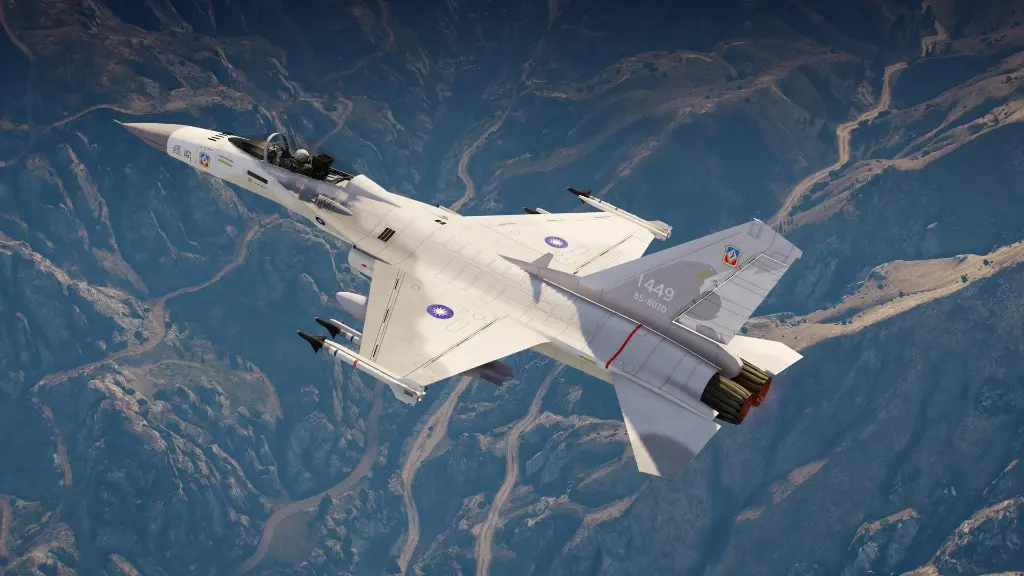AIDC F-CK-1 Ching-kuo

The AIDC F-CK-1 Ching-kuo, also known as the Indigenous Defense Fighter (IDF), is a multirole fighter aircraft developed by the Aerospace Industrial Development Corporation (AIDC) for the Republic of China Air Force (Taiwan). First flown in 1989 and introduced in 1994, the F-CK-1 was designed to counter regional threats and reduce reliance on foreign military imports. It is a lightweight, agile fighter equipped with advanced avionics and weapon systems.
Fact Sheet
| Role | Multirole fighter |
|---|---|
| Manufacturer | Aerospace Industrial Development Corporation (AIDC) |
| First Flight | 1989 |
| Service Entry | 1994 |
| Crew | 1 (F-CK-1A) or 2 (F-CK-1B) |
Specifications
| Length | 14.21 m (46 ft 7 in) |
|---|---|
| Wingspan | 9.46 m (31 ft) |
| Height | 4.42 m (14 ft 6 in) |
| Empty Weight | 6,500 kg (14,330 lb) |
| Max Takeoff Weight | 12,200 kg (26,900 lb) |
| Powerplant | 2 × Honeywell F125-70 turbofans |
| Thrust | 9,500 lbf (42.3 kN) per engine with afterburner |
| Max Speed | Mach 1.8 (2,205 km/h; 1,370 mph) |
| Service Ceiling | 16,800 m (55,100 ft) |
| Range | 1,100 mi (1,770 km) combat radius |
| Rate of Climb | ~50,000 ft/min (254 m/s) |
Avionics & Armament
| Main Radar | Golden Dragon GD-53 radar |
|---|---|
| Avionics | Advanced avionics suite, electronic warfare systems |
| Armament | One 20-mm M61 Vulcan rotary cannon; Up to 9 external hardpoints for: – Air-to-air missiles (Sky Sword I, Sky Sword II) – Air-to-ground munitions (bombs, rockets) – Precision-guided bombs – External fuel tanks |
Notable Features
- Indigenous development to reduce reliance on foreign imports.
- Multirole capability for air-to-air and air-to-ground missions.
- Advanced avionics for superior situational awareness.
- Lightweight and agile design for high maneuverability.
- Continuously upgraded with new variants like the F-CK-1C/D.

AIDC F-CK-1 Ching-kuo: Taiwan’s Indigenous Defense Fighter
The AIDC F-CK-1 Ching-kuo (Chinese: 經國號戰機; commonly known as the Indigenous Defense Fighter – IDF) is a lightweight, twin-engine, multirole combat aircraft developed by the Aerospace Industrial Development Corporation (AIDC) in Taiwan (Republic of China). Named after late President Chiang Ching-kuo, this fighter represents a significant achievement in Taiwan’s efforts to develop its own advanced defense capabilities, following the refusal of the United States to sell F-16 or F-20 fighters.
F-CK-1 Development & Strategic Imperative
The IDF program was formally initiated in May 1982, driven by Taiwan’s urgent need to modernize its air force, particularly after being denied access to advanced U.S. fighters due to diplomatic pressure from China. The project, codenamed “An-Hsiang” (Safe Flight), was divided into four main sections focusing on airframe, powerplant, avionics, and missiles. While AIDC led the program, it received crucial technical assistance from several U.S. aerospace companies, including General Dynamics (airframe), Garrett (now Honeywell, for propulsion), and others for avionics. The first prototype made its maiden flight on May 28, 1989, and the F-CK-1 entered service with the Republic of China Air Force (ROCAF) in 1992. A total of 131 production aircraft were delivered by 1999.
F-CK-1 Design Features: Agility & Digital Control
The F-CK-1 Ching-kuo features a design that incorporates influences from both the F-16 (fuselage and control surfaces) and F/A-18 (twin-engine layout and intakes), tailored to its specific requirements.
- Twin Engine Powerplant: The aircraft is powered by two Honeywell/ITEC F125-70 (formerly TFE1042-70) afterburning turbofan engines. Each engine produces a dry thrust of 27 kN (6,060 lbf) and an afterburning thrust of 42 kN (9,500 lbf), providing sufficient power for its lightweight design.
- Supersonic Performance: The F-CK-1 has a maximum speed of Mach 1.8 (approximately 2,205 km/h or 1,370 mph) and a service ceiling of 16,800 m (55,000 ft).
- Inherently Unstable Design: Like many modern fighters, its design is inherently unstable in pitch, which enhances agility. This is managed by a triple-redundant full-authority digital fly-by-wire (FBW) flight control system.
- Cockpit Layout: The cockpit is similar to that of the F-16, featuring a side-stick controller, HOTAS (Hands-On Throttle-And-Stick) controls, a Head-Up Display (HUD), and Multi-Function Displays (MFDs) (monochrome in early models, color in upgraded versions). Pilots sit on a Martin-Baker Mk 12 zero-zero ejection seat.
F-CK-1 Avionics & Armament: Indigenous Missiles & Radar
The F-CK-1’s avionics suite and armament reflect a strong emphasis on indigenous capabilities.
- GD-53 “Golden Dragon” Radar: The primary sensor is the GD-53 X-band pulse-Doppler radar, derived from the General Electric AN/APG-67(V) developed for the F-20 Tigershark, with some components from the F-16A’s AN/APG-66. It provides look-down/shoot-down capability and can simultaneously track 10 targets and engage two. Its effective scanning range is approximately 57 km (35 mi) look-up and 39 km (24 mi) look-down.
- Electronic Warfare (EW) Suite: Includes a radar homing and warning unit (RHAWS) and chaff/flare dispensers for self-protection.
- Integrated Cannon: Equipped with one 20 mm M61A1 Vulcan cannon for close-range engagements.
- Indigenous Air-to-Air Missiles (AAMs):
- Tien Chien I (TC-1) “Sky Sword I”: An infrared-guided, short-range AAM, similar in class to the AIM-9 Sidewinder.
- Tien Chien II (TC-2) “Sky Sword II”: An active radar-homing, medium-range AAM, comparable to the AIM-120 AMRAAM. The F-CK-1 can carry up to four TC-2s.
- Air-to-Surface & Anti-Ship Weapons: Can deploy various unguided bombs, cluster bombs (like the Wan Chien cluster bomb), and has been integrated with the AGM-65 Maverick air-to-surface missile. More recently, the Hsiung Feng III (HF-III) anti-ship missile is being integrated, modified for air launch, to enhance its anti-surface warfare (ASuW) capabilities.
F-CK-1 Variants & Upgrade Programs
The F-CK-1 fleet has undergone significant modernization programs to extend its service life and enhance capabilities.
- F-CK-1A (Single-Seat) / F-CK-1B (Two-Seat): The initial production variants.
- F-CK-1C/D “Hsiang Sheng” (Mid-Life Upgrade – MLU): This comprehensive upgrade program, initiated in the mid-2000s, transformed a large portion of the fleet.
- Enhanced Avionics: Digital cockpit with color MFDs, upgraded mission computers, new inertial navigation system (GPS/INS), and improved radios.
- Radar Improvements: New operational modes for the GD-53 radar, including Track While Scan (TWS) and enhanced Electronic Counter-Countermeasures (ECCM).
- Increased Missile Capacity: Ability to carry up to four TC-2 missiles.
- Integration of Advanced Munitions: Compatibility with the TC-2A anti-radiation missile and the indigenous Wan Chien cruise missile for ground attack.
- Structural Enhancements: Strengthened landing gear and increased internal fuel capacity (in some cases, with conformal fuel tanks).
- AIDC T-5 “Brave Eagle”: A new Advanced Jet Trainer (AJT) developed from the F-CK-1B two-seat variant. The T-5 has a redesigned wing, increased composite material use, and is optimized for training, though it retains light attack potential. It entered service in 2021.
F-CK-1 Current Status & Operators
- Taiwan (Republic of China Air Force – ROCAF): The sole operator.
- All 130 production F-CK-1s (initially 102 single-seat A-models and 28 two-seat B-models) were manufactured by 1999.
- The vast majority of the fleet has undergone the “Hsiang Sheng” Mid-Life Upgrade (MLU), bringing them to the F-CK-1C/D standard. These upgraded aircraft are deployed with the 1st Tactical Fighting Wing in Tainan and the 3rd Tactical Fighting Wing in Taichung.
- The F-CK-1 remains a cornerstone of Taiwan’s air defense, operating alongside the ROCAF’s F-16s and Mirage 2000s, providing a multi-layered defense strategy.
F-CK-1 Combat History & Role
The AIDC F-CK-1 Ching-kuo has no confirmed combat kills in actual warfare. Its primary role is to provide air defense and interdiction capabilities for Taiwan. In a potential conflict, the F-CK-1s are intended to be among the first to engage adversary aircraft at range with their TC-2 missiles, engage enemy warships with anti-ship missiles, and target ground installations with cruise missiles. Its indigenous nature offers Taiwan a degree of self-sufficiency in maintaining and upgrading its fighter fleet, which is crucial given geopolitical complexities.



